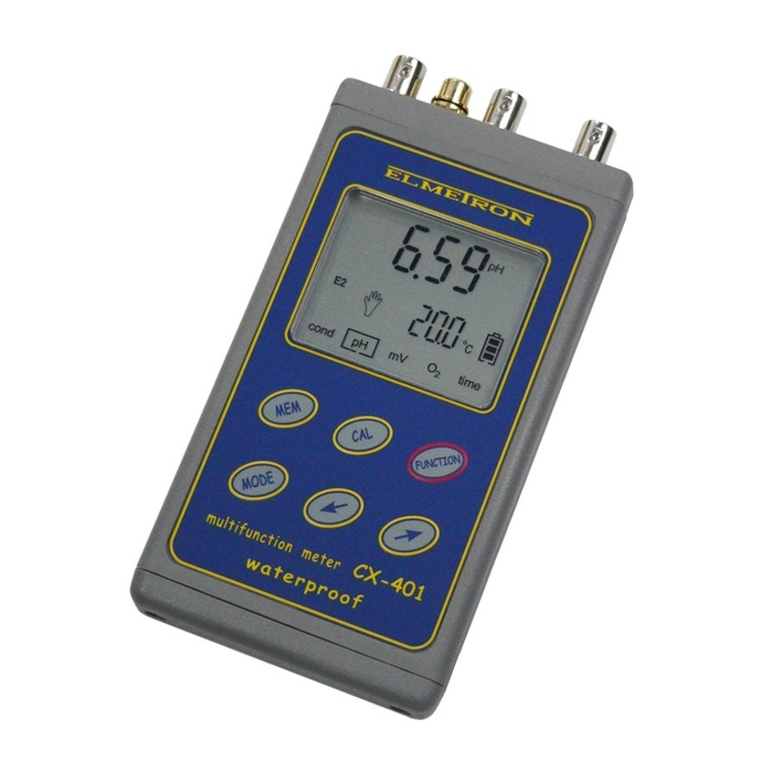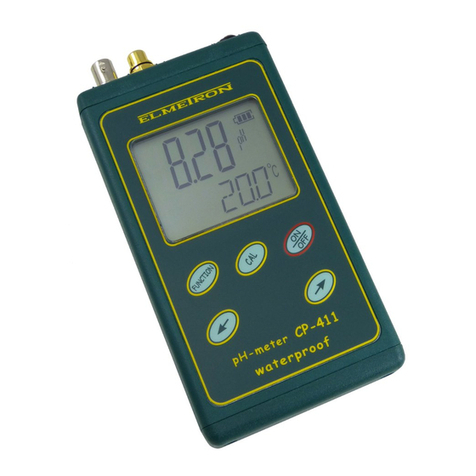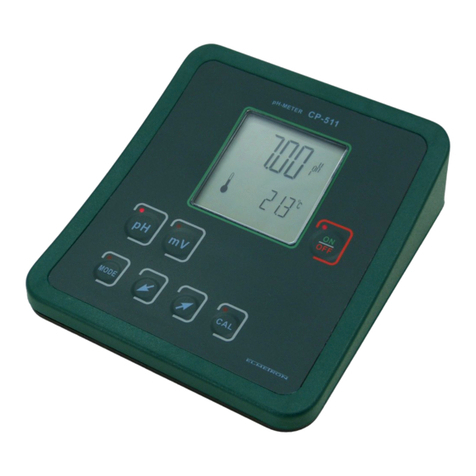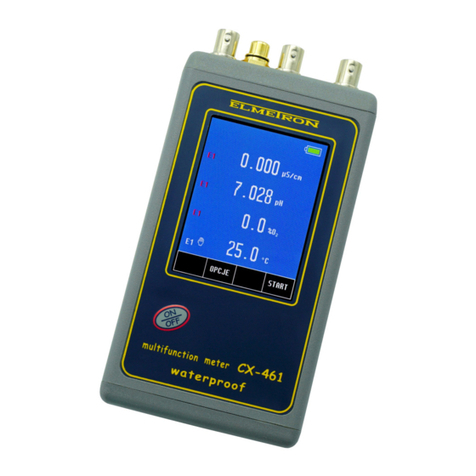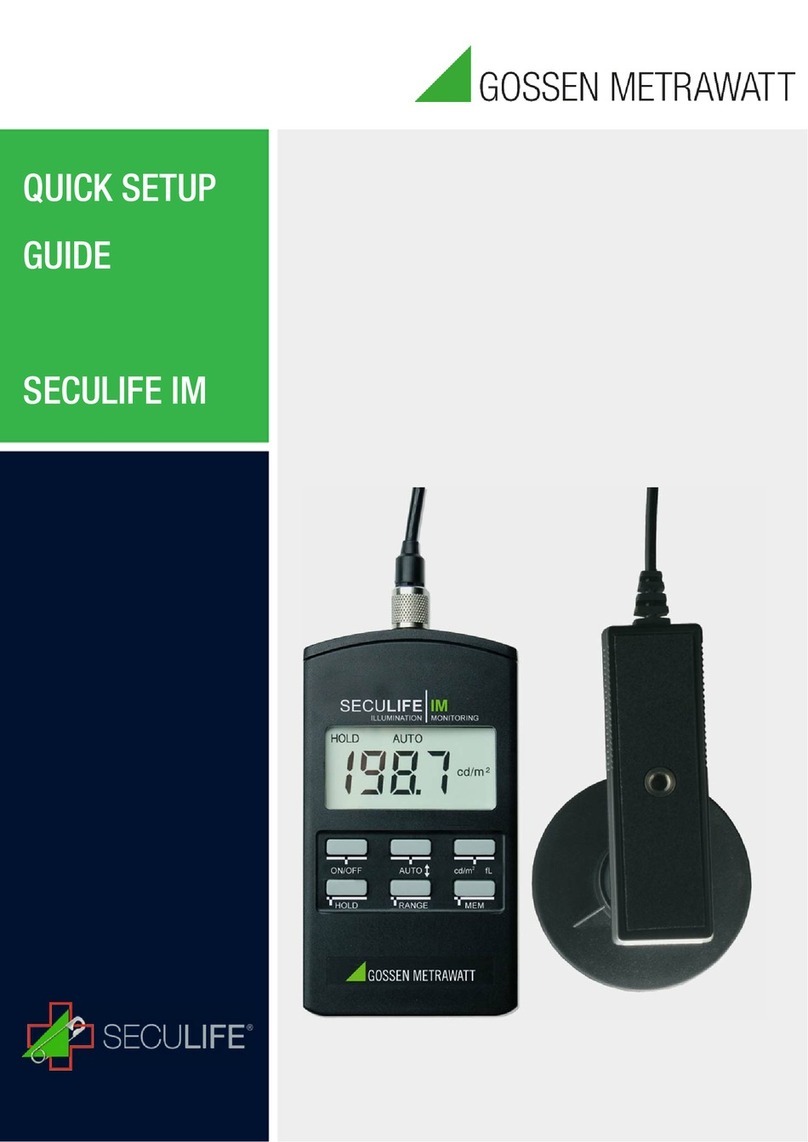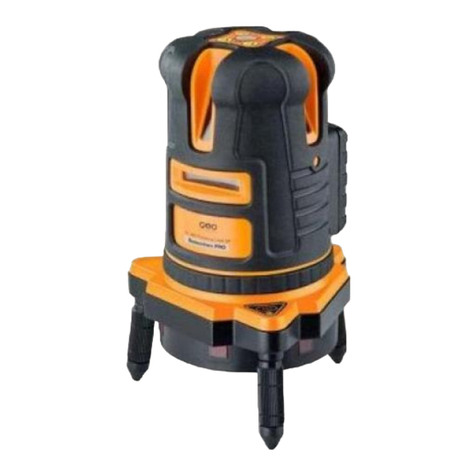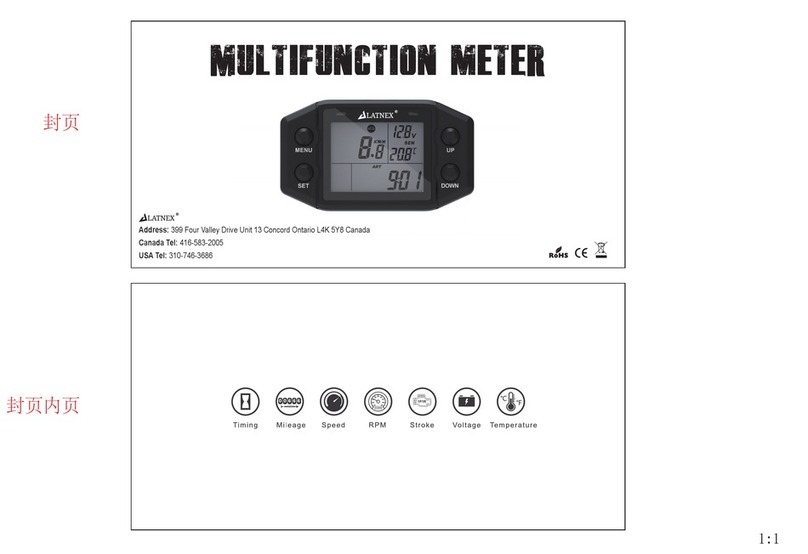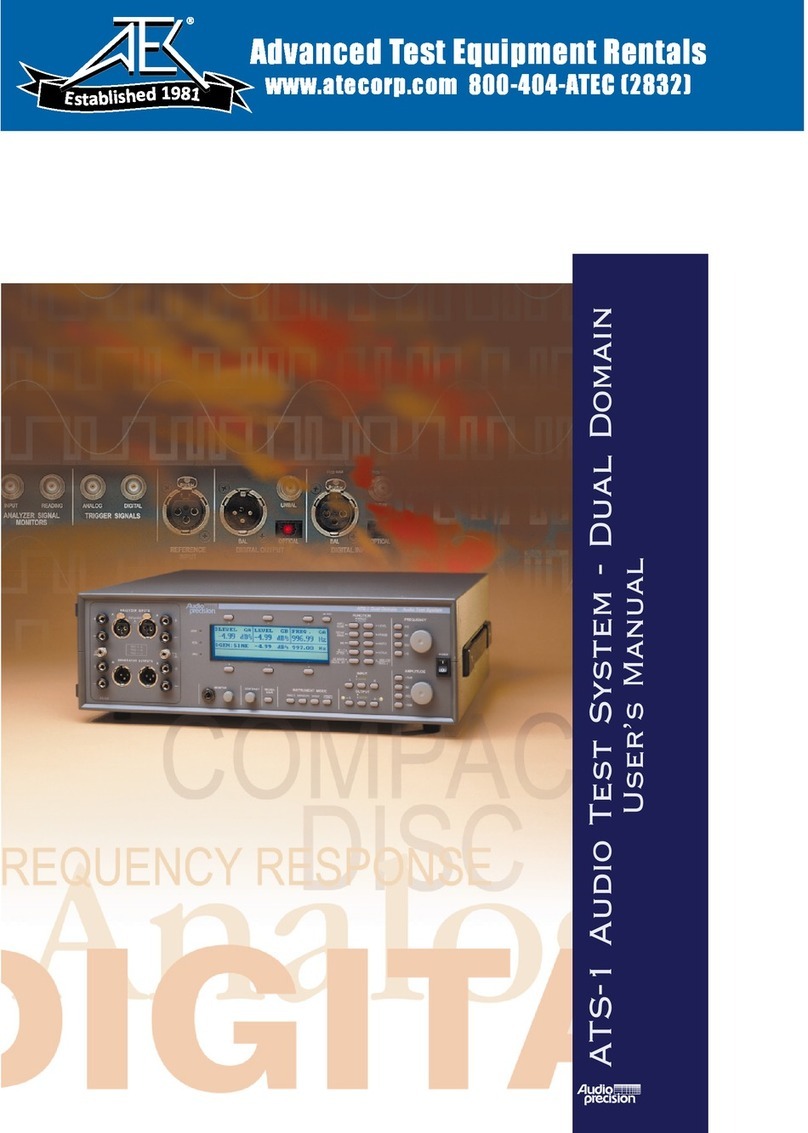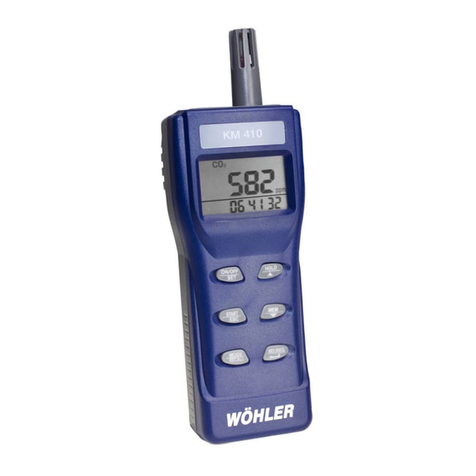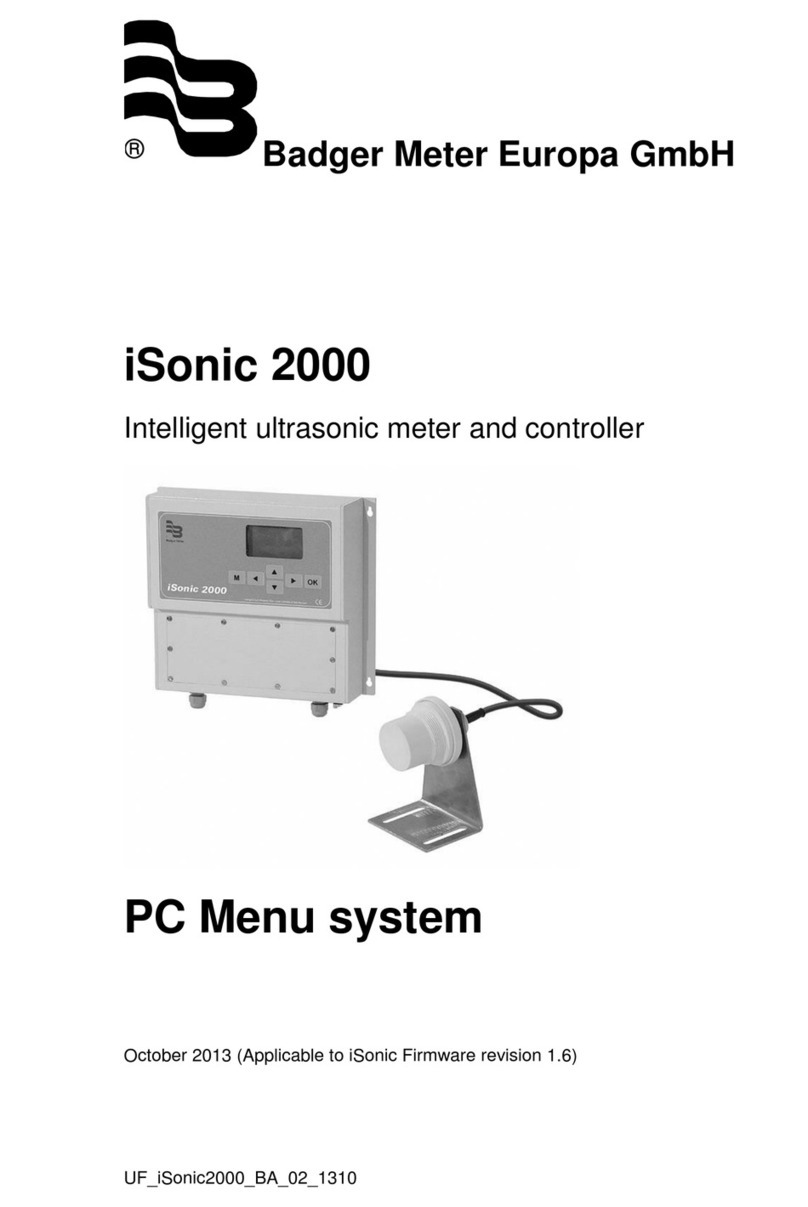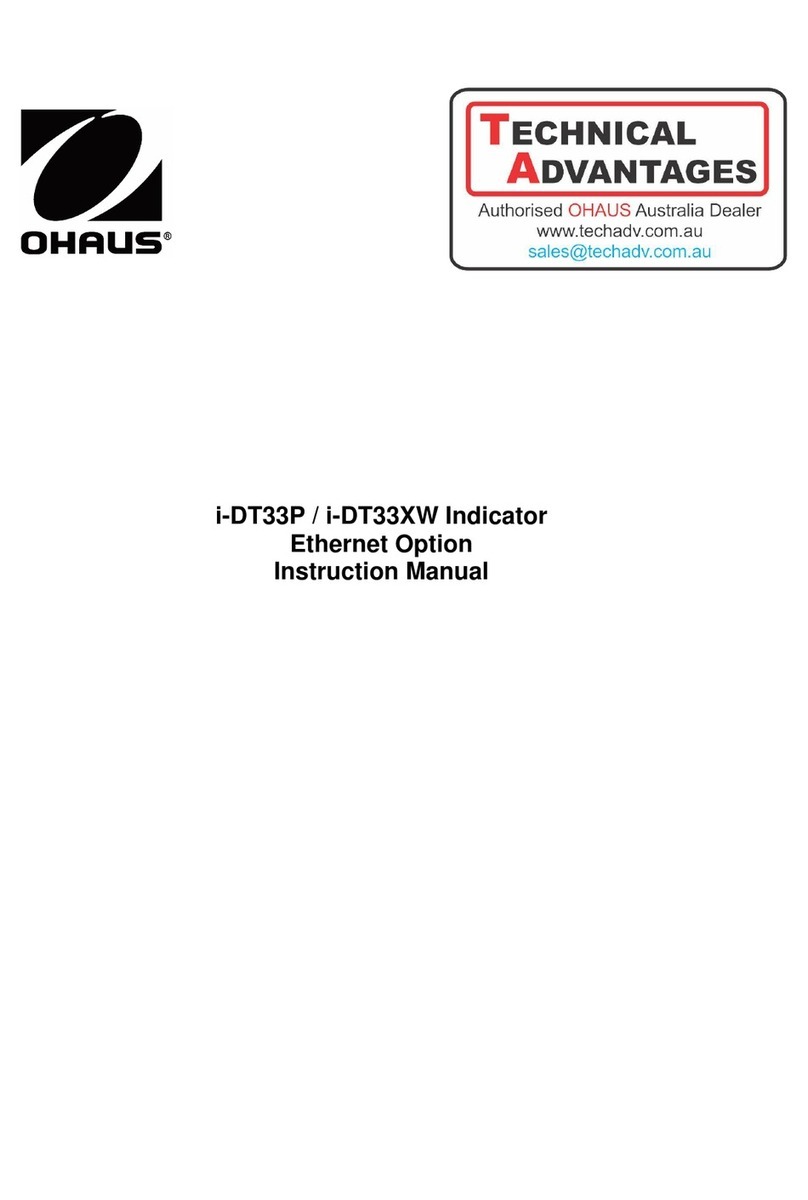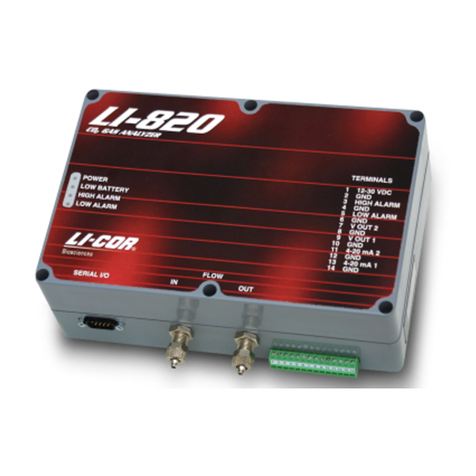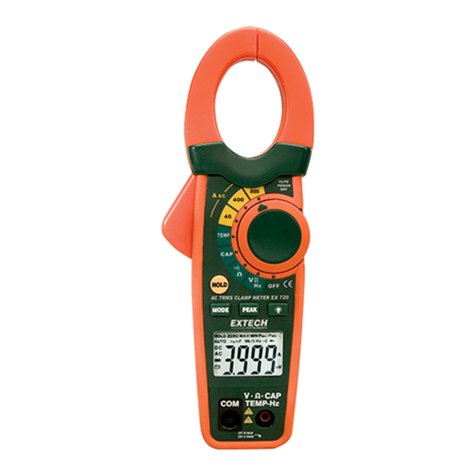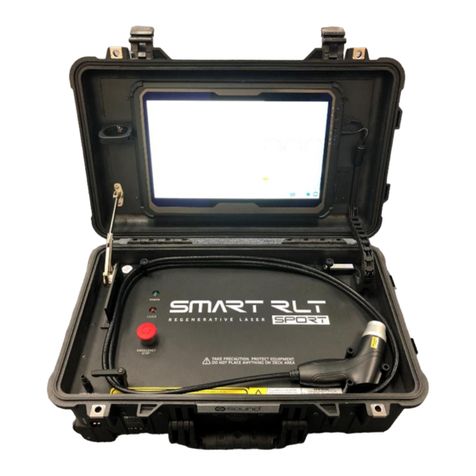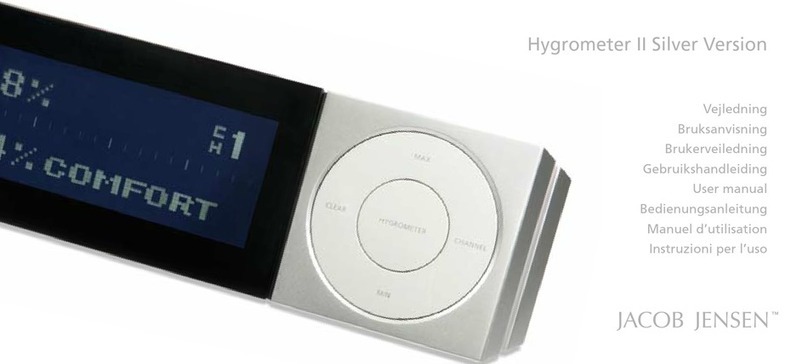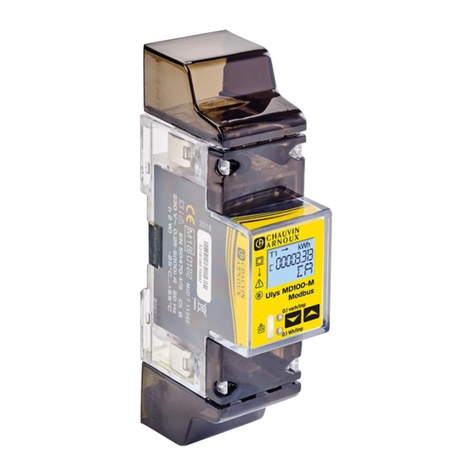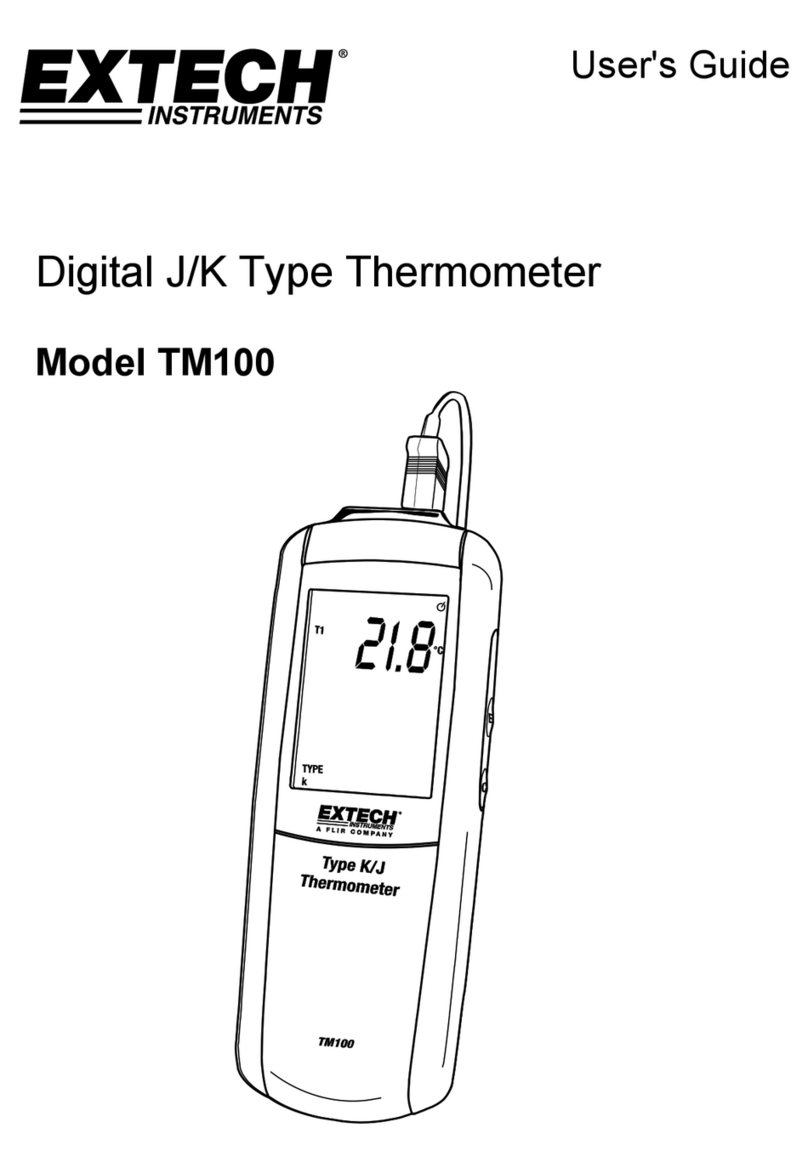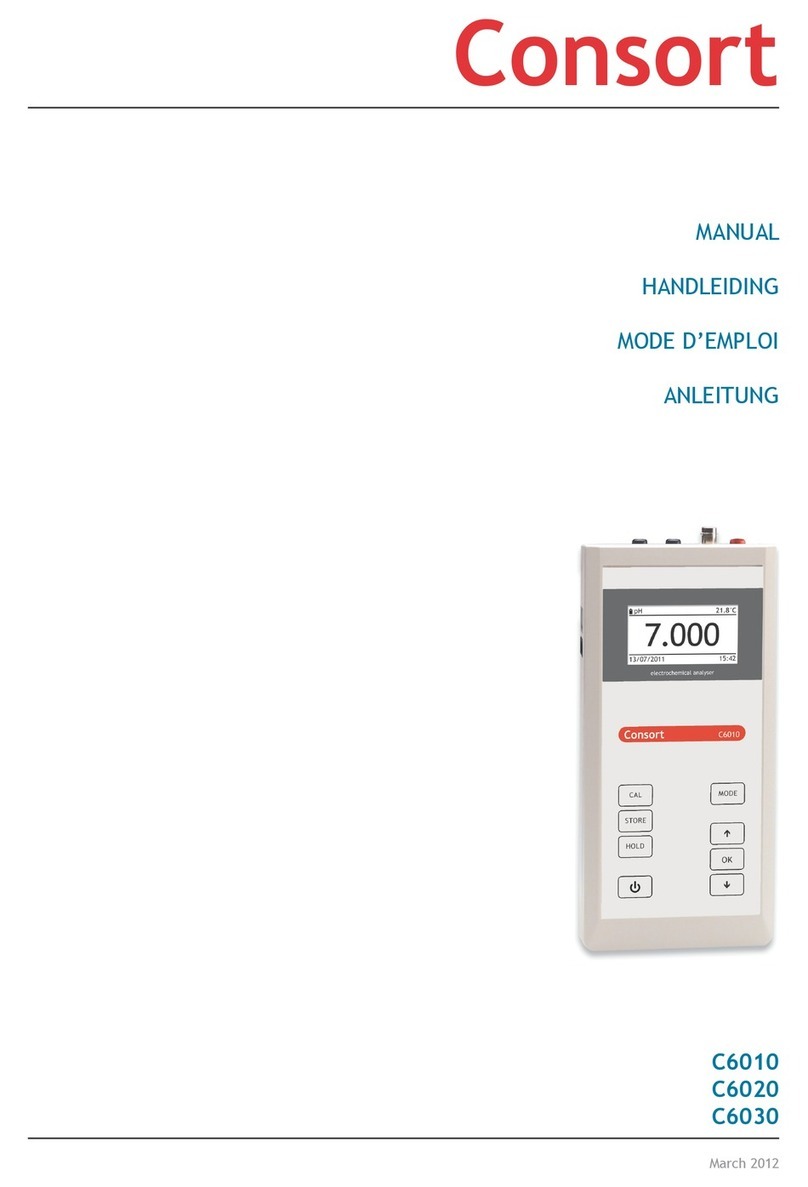ELMETRON CX-401 User manual

WATERPROOF
MULTIFUNCTION
METER
CX-401
USER‘S MANUAL


USER’S MANUAL
WATERPROOF
MULTIFUNCTION METER
CX-401
Before use please read the instructions carefully!


CONTENTS
I. Introduction 1
1.Exploitation notices 3
2.Characteristics of the meter 4
3.What is the meter designed for 6
4.The outside view 7
5.Switching the meter on and off 10
6.Preparation to work 11
6.1.Choosing the kind of the temperature compensation 11
6.2.Changing the measurement resolution 12
6.3.Switchnig the stabilised reading signalisation on and off 13
6.4.Changing the electrode number 14
6.5.Readout of the last calibration date 15
6.6.Setting the time of calibration validity 16
6.7.Defining the button functions 17
6.8.Holding the reading on the display 18
II. pH measurement 19
7.Preparation of the pH electrode 21
8.Calibration 22
8.1.Calibration with use of standard and buffer solutions 23
8.2.Entering the buffers’ values into the meter’s memory 24
8.3.Calibration in buffer solutions 26
8.4.Calibration with use of NIST compliant standard solutions 28
8.5.Calibration with manual temperature compensation 30
9.Checking the electrode condition 31
9.1.Readout of the electrode parameters after calibration 32
10. pH measurement 34
11. Notices about the temperature compensation and interpretation
of the pH measurement results 36
III. Conductivity and salinity measurement 39
12. Basic information about the conductivity measurement 41
13. Entering the conductivity measurement parameters 42
13.1. Choosing the unit 42
13.2. Entering the W
TDS
coefficient 44
13.3. Choosing the type of the temperature compensation 45
13.4. Entering the αcoefficient value 46
13.5. Entering the reference temperature value 47
14. Maintenance of the conductivity cell 48
15. Calibration 49
15.1. Calibration without standard solution 49
15.2. Calibration with use of standard solutions 50
16. Conductivity measurement 55
16.1. Measurement without the temperature compensation 55
16.2. Measurement with automatic temperature compensation 56
16.3. Measurement with manual temperature compensation 57
17. Salinity and total dissolved solids measurement 58
17.1. Salinity measurement with conversion to NaCl or KCl 59
17.2. Determining the W
TDS
coefficient 60

17.3. The salinity measurement with conversion to TDS 60
18. Notices about temperature compensation 61
18.1. Natural water 61
18.2. Ultra pure water 61
19. Simplified way of determining the αcoefficient 63
IV. Oxygen concentration measurement 65
20. Basic information about oxygen measurement 67
21. Entering the oxygen measurement parameters 69
21.1. Changing the unit 69
21.2. The salinity influence compensation 70
21.3. Automatic compensation of the atmospheric pressure influence 73
22. Calibration of the oxygen sensor 74
22.1. Readout of the sensor parameters after calibration 76
23. Measurement of dissolved oxygen concentration in water 77
23.1. Measurement with automatic temperature compensation 78
23.2. Measurement with manual temperature compensation 78
24. Measurement of oxygen saturation in air 79
V. Atmospheric pressure measurement 81
25. Atmospheric pressure measurement 83
VI. Redox potential and temperature measurement 85
26. Entering the potential offset parameters 87
26.1. Choosing the mode of measurement 87
26.2. Entering the reference potential value 88
27. Redox potential measurement 89
28. Temperature measurement 89
VII. Other 91
29. Clock with date 93
29.1. Clock 93
29.2. Date 93
29.3. Setting time and date 93
29.4. Auto switch off function 94
29.5. Switching the sound on and off 95
29.6. The LCD backlight mode 95
29.7. The brightness control 96
29.8. Readout of the software version number, date of production and date
of manufacturer‘s calibration 97
30. Storing and readout of the results 98
30.1. Parameters of storage and readout from the memory 98
30.2. Recording single readings 100
30.3. Collecting measuring series 100
30.4. Reviewing the readings 101
30.5. Deleting stored readings 101
31. Calibration report 102
32. Cooperation with a PC 102
33. Power, replacing the rechargeable battery 104
34. Technical data 105
35. Equipment 108

- 1 -
I. INTRODUCTION

- 2 -
User‘s manual for CX-401 multifunction meter v6.0x

- 3 -
1. EXPLOITATION NOTICES
Dear User!
We present you a device distinguished by accuracy according to the
technical data and by a high stability of the displayed results. We believe that
the measurements would not cause you any trouble and that the meter would
operate without any inconvenience. Wide range of additional functions
requires careful reading of the manual, in other case some of the
features may stay unused or using the meter may be troublesome.
Using electrodes of good quality and replacing them after a suitable time
ensures obtaining high measuring accuracy. It is worth remembering that
electrodes have much shorter life time than the meter. Deterioration of the
result stability and increase of the measuring error are typical symptoms of
an improper work of the electrode. Some problems users have may arise
from using pH electrodes not being conditioned before the
measurement, making measurements not having removed the shielding
ring from the liquid junction, with contaminated membrane or plugged
junction, making measurements not taking the membrane cap off. To
avoid such situations it is necessary to choose a proper kind of electrode for
solutions which are going to be measured, e.g., sewage, liquids with
deposits, meat, cheese etc. Therefore, if you observe improper operation of
the device, please take control measurements with another electrode. In
most cases deterioration of the meter’s work is caused by the electrode
and not by the meter itself.
In case of conductivity measurements it is important to choose the cell with
a K constant value suitable for the measuring range. Improper selection may
cause larger error occurrence, what may also happen during measurements
with automatic temperature compensation with an inappropriate α
αα
αcoefficient
introduced.
Accuracy of the dissolved oxygen measurements depends on the sensor’s
calibration and regular conservation which consists in replacing the
membranes, electrolyte and cleaning the electrodes. Neglecting these
activities after some time would make measurements impossible.
Please turn your attention to the fact that stabile measurement is
possible only with natural or simulated water flow.
The essential feature of our products is their low failure frequency. However,
in case of the meter’s failure, our firm provides its immediate repair under the
warranty conditions.
We wish you a pleasant and trouble-free work with our meter.

- 4 -
User‘s manual for CX-401 multifunction meter v6.0x
2. CHARACTERISTICS OF THE METER
CX-401 multifunction meter belongs to the newest generation of measuring
devices. It offers wide range of additional functions. The meter ensures high
accuracy and repeatability of readings. Two kinds of power source: the
rechargeable battery and the power adapter, enable work in field and long-
lasting measurements in the laboratory. The meter’s memory is independent
from power supply. The meter is equipped with a large backlit custom LCD
display, enabling observing simultaneously: the measured function, the
temperature value and additional symbols which make working easier.
Waterproof housing makes working in difficult conditions possible. Minimised
size and weight make the meter very handy especially during field work.
Main features of CX-401 are:
-high accuracy and stability of readings;
-automatic and manual temperature compensation;
-pH electrode calibration in 1 to 5 points;
-automatic recognition of pH buffers and standards;
-factory set values of buffer solutions with possibility of changing their
value by the user;
-option of automatic introduction of temperature influence on the value of
pH buffer solutions (NIST norm);
-information about the pH electrode condition;
-storing of the date and calibration characteristics of three electrodes
(sensors) in each function;
-possibility of introducing the time of calibration validity and signalling its
expiry;
-wide range of conductivity measurement with 6 automatically switched
subranges (autorange);
-converting the conductivity to salinity in NaCl or KCl (g/l or %) according
to actual dependence to conductivity;
-converting conductivity to TDS (g/l or %) with possibility of introducing the
TDS coefficient;
-measurement of resistivity in Ωcm;
-temperature compensation for measurements in natural, pure and ultra
pure water;
-calibration of the conductivity cell by introducing the K constant or in 1 to
5 standard solutions;
-function of determining K constant of the cell;
-compensation of the salinity influence on the oxygen measurement with
use of the salinity measured by the meter;
-measurement and automatic compensation of the atmospheric pressure
influence on the oxygen measurement;
-signalising of the reading stabilisation (READY);
-holding the reading on the display (HOLD);
-storing measurement results with time, date and temperature, taken as
single or series of measurements with set time interval;

- 5 -
-possibility to create the last calibration report or readout of last 10
calibration data of each measuring function in the data transmission
software;
-microUSB output for connecting with PC and charging the rechargeable
batteries;
-large LCD backlit display with brightness control;
-real time clock with date;
-automatic switch off after time set by the user.

- 6 -
User‘s manual for CX-401 multifunction meter v6.0x
3. WHAT IS THE METER DESIGNED FOR
CX-401 multifunction meter is a precise and easy-to-use meter designed for
measurements of hydrogen ion concentration in pH units, redox potential
(mV), conductivity of solutions in in S/cm, resistivity in Ωcm, concentration of
oxygen dissolved in water in % or mg/l, oxygen saturation in air in % and
atmospheric pressure measurement in hPa. The meter can be also used for
accurate measurements of the temperature of solutions and air in °C.
For measurements in pure and ultra pure water suitable temperature
compensation may be chosen.
The conductivity reading can be displayed in S/cm or in concentration units
(g/l or %) counted to NaCl, KCl or TDS. Waterproof housing enables work in
difficult weather conditions or in humid environment.
CX-401 is used in food, chemical, pharmaceutical and power industries, in
water treatment stations, laboratories, agriculture, universities, scientific
laboratories etc.
The meter is prepared to work with all types of combination pH electrodes and
conductivity cells, with wide K constant range, equipped with the BNC-50
connector. It is possible to connect the meter with two electrodes (pH
measuring and reference) by special adapter offered as an additional
equipment. CX-401 cooperates with Pt-1000 temperature probe with the
Chinch connector.
The meter may store measurement results taken as single or series of
measurements with set time interval. The USB interface enables sending the
stored results. When the collected series exceed the memory capacity, it is
possible to use included software.

- 7 -
4. THE OUTSIDE VIEW
On the front wall of the meter there is a LCD display (Pic. 1), on which
depending on the chosen function following symbols are displayed:
-result of the pH measurement in pH units;
-result of the redox potential measurement in mV;
-result of the conductivity or salinity measurement;
-result of the oxygen concentration in % or mg/l
-time and date.
Choosing the function by the button is signalised by the frame displayed
around the symbol of the chosen function in the lower part of the display:
cond (conductivity), pH, mV, O
2
or time. Simultaneously with the result a
measured temperature value in
o
C is displayed. Symbols of units are
displayed next to the results. In the dissolved oxygen measurement mode
readout of the air pressure is possible.
Pic. 1.
Next to the temperature value the symbol for automatic temperature
compensation or the
symbol
for manual compensation is displayed
.
The
CAL symbol on the left informs that the meter is in the calibration mode.
The number of the chosen electrode is displayed on the left (E1, E2, E3). It
informs which of the characteristics would be taken into consideration during
all calculations. Blinking symbol of the electrode number informs that its
characteristic was deleted, the calibration validity has expired (point 6.6) or
that the last calibration indicated that the pH electrode had lost its efficiency.
The number of detected calibration point is displayed during calibration
process between the upper and the lower row of digits (P1, P2, P3, P4, P5).
In the MODE mode all parameters set by the user and the value of the air
pressure measurement (for the O
2
measuring mode) are displayed. The
rechargeable battery condition is signalised by the symbol.

- 8 -
User‘s manual for CX-401 multifunction meter v6.0x
The keyboard (Pic. 2) placed below the display is used for switching the
meter on and off, choosing the measuring function, calibration, entering the
parameters and storing the results in the memory.
The keyboard is equipped with the following keys:
- pressing shortly switches the meter on, enables changing the
function, pressing and holding switches the meter off.
- pressing and holding enters the calibration mode (CAL symbol
displayed). Pressing shortly in this mode confirms the
calibration result.
- pressing shortly holds the reading on the display, records the
reading or starts the measuring series.
- pressing and holding this button enters reviewing the stored
readings.
- chooses the entered parameter.
,- buttons used for entering the parameters.
In the upper wall of the meter inputs are placed with the symbols given below:
pH - the BNC-50 input for connecting the combination pH electrode or
the redox electrode;
t- the Chinch input for connecting the temperature probe;
O2 - the BNC-50 input for connecting the oxygen sensor;
USB - microUSB input for connecting the power adapter or with the PC;
Cond - the BNC-50 input for the conductivity cell.

- 9 -
Pic. 2.

- 10 -
User‘s manual for CX-401 multifunction meter v6.0x
5. SWITCHING THE METER ON AND OFF
After switching it on with the button, the meter tests the memory and the
display on which all symbols are displayed (Pic. 3).
Pic. 3.
If the test ends successfully, after about 1.5 s the meter switches
automatically to the measuring mode, in which it was switched off. If a
sign is displayed it means that the meter has lost the factory settings and
requires the service repair. If after 1,5 s all symbols are continuously
displayed it informs that the calibration parameters of electrodes or cells have
been lost.
After pressing the meter adopts standard characteristics:
-offset = 0 pH, slope = 100% for the pH electrode;
-K constant = 1.000 cm
-1
for the conductivity cell;
-offset = 0% O
2
, slope = 100% O
2
for the oxygen sensor
and enters the measuring mode. It is necessary to calibrate the conductivity
cell the pH electrode and the oxygen sensor.
The meter is switched off by pressing and holding the button until the
symbol displays. When the meter is powered by the rechargeable
batteries only, it switches automatically off after the time of non-use set by
the user (description in the chapter 29.4). This function is deactivated during
calibration, while collecting series of measurements and working with the
power adapter.

- 11 -
6. PREPARATION TO WORK
Before starting work:
-connect prepared combination pH electrode or redox electrode to the pH
(BNC-50) input;
-connect oxygen sensor to the O2 (BNC-50) input;
-connect conductivity cell to the Cond (BNC-50) input;
-in case of using the temperature probe connect it to the t (Chinch)
temperature input;
-in case of working with a PC connect a suitable cable to
the microUSB input
-switch the meter on by pressing the button.
The pH electrode is isolated from the conductivity cell, therefore during the
pH and the conductivity measurements both electrode and cell may be
immersed in the same solution simultaneously.
6.1. Choosing the kind of the temperature compensation
The meter switches to the automatic or manual temperature compensation
mode itself. Connecting the temperature probe switches the automatic
temperature compensation on. Next to the measured value the symbol is
displayed. After disconnecting the probe the meter enters the manual
temperature compensation mode. In place of the symbol the is
displayed, at the same time the buttons , are being unlocked and
changing the temperature with their use is possible.

- 12 -
User‘s manual for CX-401 multifunction meter v6.0x
6.2. Changing the measurement resolution
The measurement results can be displayed with a chosen resolution. Setting
the resolution:
- in the measuring mode press the button, the (display) symbol
will appear, Pic. 4.
- with the , buttons choose:
- low resolution;
- high resolution.
Pic. 4.
For the pH measurement:
- 0.01 pH resolution;
- 0.001 pH resolution.
For the conductivity measurement:
- 3½ digit resolution;
- 4½ digit resolution.
For the O
2
concentration measurement:
- 1% or 0.1mg/l resolution;
- 0.1% or 0.01 mg/l.
For the mV measurement:
- 1 mV resolution;
- 0.1 mV resolution.
Return to the measuring mode by pressing the button.

- 13 -
6.3. Switchnig the stabilised reading signalisation on and off
The meter may signalise that the reading has stabilised. To switch the
signalisation on and off:
-in the measuring mode press the button, the (display);
-press the button shortly, the READY symbol will appear (Pic. 5.), the
signalisation is switched on. After pressing the button once again the
READY symbol disappears and switches the signalisation off.
Pic. 5.
After switching the signalisation on each reading stabilisation will be
signalised with and READY symbol and sound signal – if the second has
been activated (section 29.5). If the value changes and exceeds the
stabilised reading range, the READY symbol will disappear.
Return to the measuring mode by pressing the button.

- 14 -
User‘s manual for CX-401 multifunction meter v6.0x
6.4. Changing the electrode number
If there has been more than one electrode’s characteristic stored in the
meter’s memory, it is possible to replace the electrodes without the need of
calibration. This option is quite useful in case of working in the field. It is
necessary to connect the electrode calibrated earlier and choose its number
given during calibration.
In order to do so, in the measuring mode:
- press the button until the , or symbol displays in the upper
row of the display, than using the , buttons choose the number
under which the calibration data will be stored (Pic. 6). Below the
electrode number one of the following symbols will be displayed:
- under this number there is no characteristic stored and the factory
values are provided. In the measuring mode the electrode number
will be blinking.
- under this the last calibration data are stored.
- the last calibration indicated that the electrode is loosing its
efficiency and in a short time its calibration may not be possible
(for the pH function only). In the measuring mode the electrode
number will be blinking.
Additionally the points in which the electrode has been calibrated are shown
under its number.
Pic. 6.
-return to the measuring mode by pressing the button.
Note: while changing the electrode remember about choosing the
relevant electrode number in the meter.
Other manuals for CX-401
1
Table of contents
Other ELMETRON Measuring Instrument manuals
